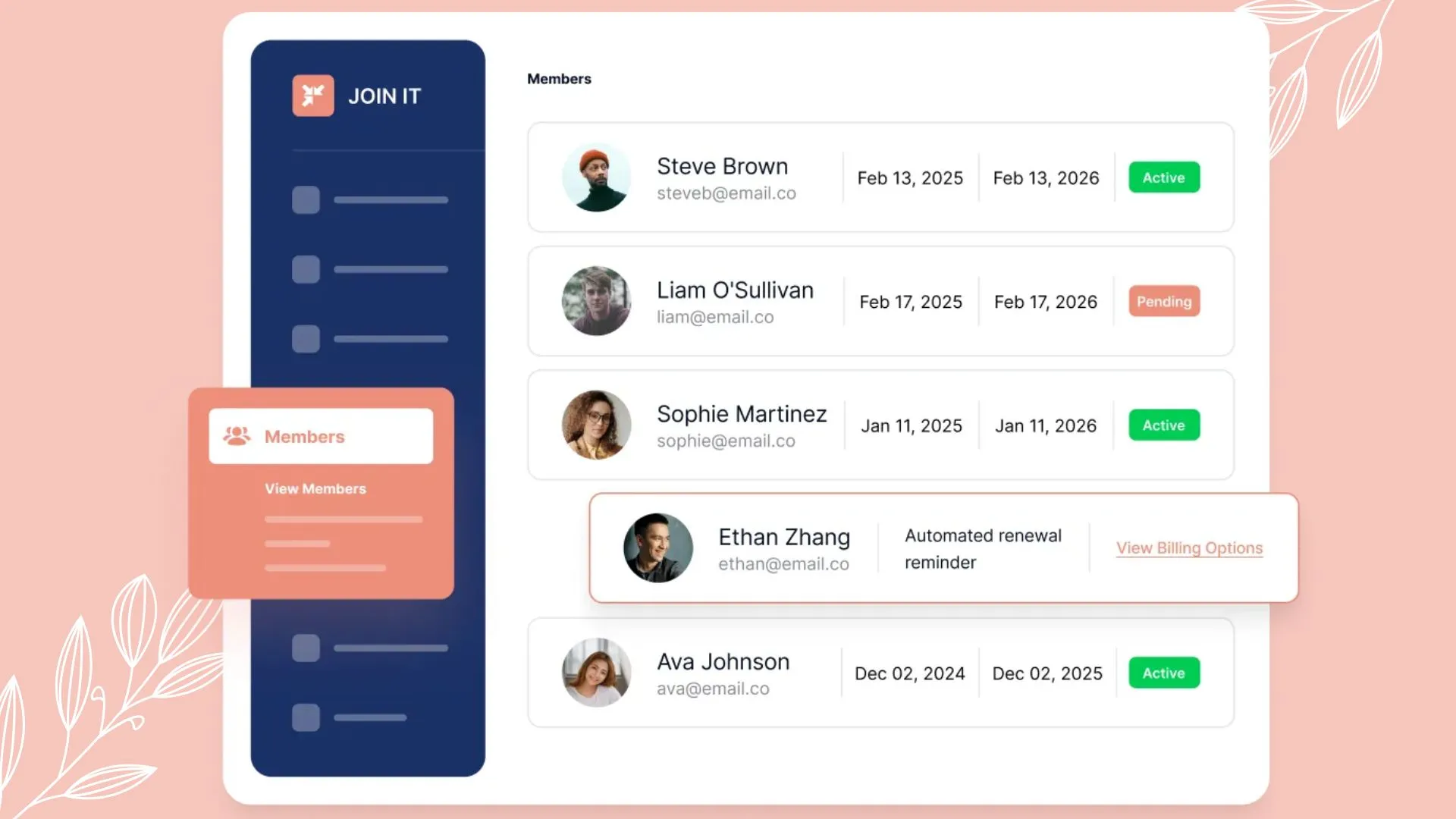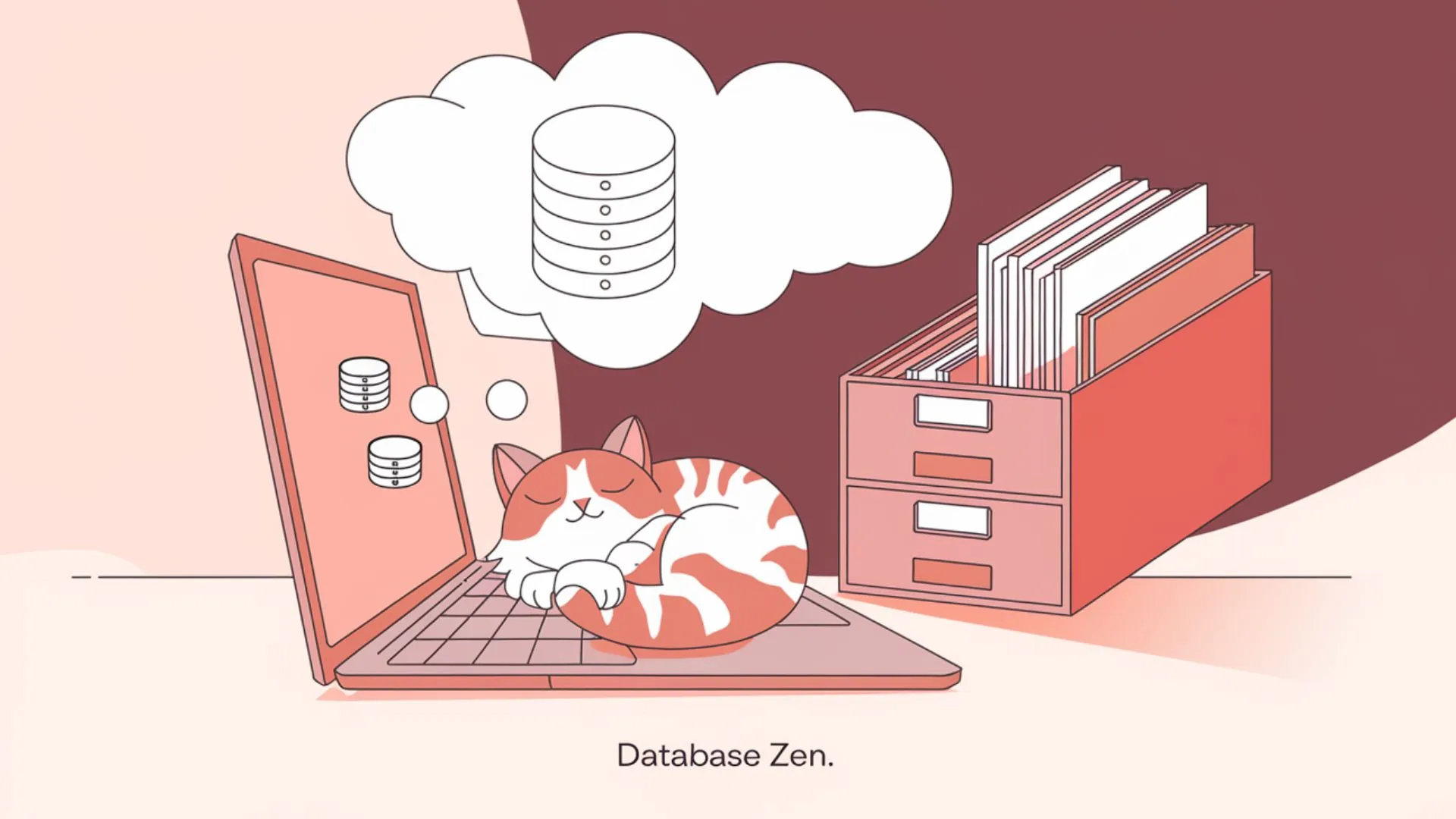
Ever felt like your business data is scattered everywhere—spreadsheets here, sticky notes there, and a dash of “where did I save that file?” thrown in for good measure?
You’re not alone. In 2025, founders, business owners, and organization leaders are realizing that proper database management software (DBMS) isn’t just a “nice-to-have”—it’s the backbone of smart, scalable growth.
But with so many options (and so much jargon), how do you pick the right one? This guide breaks it all down—no PhD required. We’ll cover what DBMS is, why it matters, how to choose, and review the top 12 tools (with Join It leading the pack).
Ready to turn your data chaos into clarity? Let’s dive in. 🚀
What Is Database Management Software?
Think of database management software as your business’s digital filing cabinet—except it never loses a file, always knows where everything is, and can automate half your admin work.
A good DBMS lets you:
- Store and organize all your data (members, customers, transactions, inventory—you name it)
- Search, update, and analyze information instantly
- Control who can access or edit what
- Integrate with your favorite business tools
Why Your Business Needs a DBMS (Benefits)
Still using spreadsheets? Here’s what you’re missing out on:
- Centralized data (no more duplicate entries or version confusion)
- Security and compliance (protect sensitive info, stay audit-ready)
- Automation (set up reminders, syncs, and workflows)
- Scalability (grow from 10 to 10,000+ records without breaking a sweat)
- Better decisions (real-time analytics at your fingertips)
According to recent industry research, companies investing in modern DBMS see faster growth, fewer errors, and happier teams.
Key Features to Look For
Not all database software is created equal. Here’s your must-have checklist:
- Ease of use (intuitive UI, minimal training required)
- Custom fields and flexible data models
- Automation & integrations (connect with tools like Mailchimp, QuickBooks, Zapier)
- Robust security (role-based access, encryption, backups)
- Scalability (can it handle your growth?)
- Reporting & analytics (see what’s working, spot trends)
- API access (for advanced users and integrations)
- Reliable support (because when things go wrong, you want help—fast)
Need more? Here’s a guide on what data you should collect.
Types of Database Management Software
- Directory-based (great for memberships, clubs, nonprofits)
- Relational (RDBMS) (structured tables, classic SQL)
- NoSQL/Non-relational (flexible, handles unstructured data)
- In-memory (super-fast, real-time analytics)
- Cloud-based (no hardware, easy scaling)
- Object-oriented, hierarchical, time-series, graph, and more (specialized needs)
How to Choose the Right DBMS
Step-by-step:
- List your must-haves (automation? analytics? integrations?)
- Match your data model (structured, unstructured, time-series, etc.)
- Think about scale (now and in 2–5 years)
- Check for security/compliance (especially for sensitive data)
- Test support (send a question—see how fast they respond)
- Try before you buy (free trials are your friend!)
Reddit wisdom: Many founders on r/smallbusiness regret not prioritizing automation and CRM features early on.
The Top 12 Database Management Software Options (2025)
Here’s the main event—your shortlist of the best DBMS tools for modern businesses and organizations.
1. Join It

Best for: Membership organizations, businesses, nonprofits, clubs, associations
Overview:
Join It is a cloud-based platform built for non-technical users who want to organize members, automate renewals, and integrate with their favorite tools. It’s clean, intuitive, and designed to make membership management a breeze.
Key Features:
- Custom member database with flexible fields
- Digital membership cards (Apple/Google Wallet support)
- Automated renewals, payment processing, and reminders
- Seamless integrations (Mailchimp, QuickBooks, Eventbrite, Zapier)
- API access for advanced automation
- Multi-user access (see how it works)
Pricing:
- Starter: $29/month
- Total Package: $99/month
- Extra Package: $199/month
User Reviews:
- Capterra: 4.7/5 stars
- G2: 4.8/5 stars
Free Trial: Yes, 30-day free trial available
2. MySQL
Best for: Web and enterprise applications, developers, and IT teams
Overview:
MySQL is the world’s most popular open-source relational database. It powers everything from small websites to massive enterprise apps.
Key Features:
- ACID-compliant transactions
- Multiple storage engines (InnoDB, MyISAM)
- Replication, backup, and clustering
- SQL query language, stored procedures, triggers
User Love:
4.6/5 on Capterra. Users like its flexibility and performance.
Pricing:
Community Edition is free. Enterprise support starts at ~$5,350/year ( Oracle’s price list).
3. MongoDB
Best for: Fast-growing, flexible data (analytics, IoT, content-heavy apps)
Overview:
MongoDB is a NoSQL document database that stores data as JSON-like documents. Great for handling unstructured or rapidly changing data.
Key Features:
- Schema-less JSON storage
- Automatic sharding and replication
- Powerful aggregation and search
- Multi-language support
Pricing:
- Free: $0/hour (512 MB, shared resources)
- Flex: $0.011/hour (up to $30/month, up to 5 GB, shared resources)
- Dedicated: $0.08/hour (10 GB storage, 2 GB RAM, 2 vCPUs)
User Reviews:
- Capterra: 4.7/5 stars
4. Redis Enterprise
Best for: Real-time analytics, caching, high-speed data
Overview:
Redis Enterprise is a commercial, in-memory DBMS. It’s lightning-fast and perfect for real-time dashboards and session management.
Key Features:
- In-memory architecture for ultra-low latency
- Advanced data structures (sorted sets, streams)
- Built-in clustering and failover
- Modules for search and analytics
User Love:
4.8/5 on Capterra.
Pricing:
- Redis Flex: From $0.007/hour (≈$5/month)
- Essentials: From $0/hour (Free tier)
- Pro: From $0.274/hour (≈$200/month)
5. Snowflake
Best for: Cloud data warehousing and analytics
Overview:
Snowflake is a fully managed, cloud-native data warehouse. It’s built for organizations that want to analyze massive datasets with minimal hassle.
Key Features:
- Instant elasticity (scale compute up/down)
- Handles structured and semi-structured data
- Secure data sharing and replication
- Pay-as-you-go pricing
User Love:
4.7/5 on Capterra.
Pricing:
- Standard: $2.00/credit
- Enterprise: $3.00/credit
- Business Critical: $4.00/credit
- Virtual Private Snowflake: Contact for pricing
- On-Demand Storage: $23.00 per TB/month
6. InterSystems IRIS
Best for: Complex data models (healthcare, finance, IoT)
Overview:
InterSystems IRIS is a multi-model platform supporting object, relational, and JSON data.
Key Features:
- Unified data management (object, SQL, JSON)
- ACID transactions, multi-master replication
- Interoperability and built-in web server
User Love:
Praised for speed and flexibility. 4.7/5 on Capterra.
Pricing:
Contact vendor for quote.
7. MarkLogic
Best for: Hierarchical data, XML/JSON, government, publishing
Overview:
MarkLogic is a multi-model database that excels at managing complex, hierarchical data.
Key Features:
- Schema-flexible document storage (XML, JSON)
- Built-in search and graph queries
- Advanced security and replication
User Love:
5/5 on Capterra.
Pricing:
Contact vendor for quote.
8. InfluxDB
Best for: Time-series data (IoT, monitoring, analytics)
Overview:
InfluxDB is optimized for ingesting and analyzing massive volumes of timestamped data.
Key Features:
- High-throughput writes, efficient compression
- Powerful time-series query language
- Integrates with Grafana for visualization
User Love:
4.6/5 on Capterra.
Pricing:
Open-source is free; cloud pricing is tiered.Contact vendor for quote.
9. SingleStore (MemSQL)
Best for: Real-time analytics, NewSQL, high-speed transactions
Overview:
SingleStore combines the scalability of NoSQL with the power of SQL. Great for real-time analytics and mixed workloads.
Key Features:
- Distributed SQL processing
- In-memory and on-disk storage
- Real-time streaming ingestion
User Love:
4.5/5 on Capterra.
Pricing:
- Shared (Managed): Free
- Standard (Managed): From $0.90/hour
- Standard (BYOC): Contact for pricing
- Enterprise (Managed): From $1.35/hour
10. RaimaDB
Best for: Embedded, network-style databases (IoT, automation)
Overview:
RaimaDB is a compact, high-performance embedded DBMS used in networked or IoT applications.
Key Features:
- Embedded deployment, minimal resources
- Network (CODASYL) and relational models
- In-memory or disk-based storage
User Love:
5/5 on Capterra.
Pricing:
By license; request a quote.
11. Vertica (OpenText Analytics Database)
Best for: Big data analytics, data warehouses, BI
Overview:
Vertica is a columnar analytics DBMS built for high-speed, large-scale data warehousing.
Key Features:
- Massively parallel processing (MPP)
- Columnar storage and aggressive compression
- Built-in machine learning functions
User Love:
4.8/5 on Capterra.
Pricing:
Subscription or perpetual license. Contact for quote.
12. Neo4j
Best for: Graph data, social networks, fraud detection, knowledge graphs
Overview:
Neo4j is a leading graph database for highly connected data.
Key Features:
- Native graph storage and Cypher query language
- Pattern-matching queries, visualization tools
- ACID transactions, clustering, and role-based access
User Love:
4.5/5 on Capterra.
Pricing:
Community Edition is free; AuraDB cloud starts at ~$65/month.
Common Challenges & Real-World Tips
- Migration headaches: Test imports and clean up your data before going live.
- Hidden costs: Watch for extra charges (integrations, API, advanced features).
- Learning curve: Pick a tool that matches your team’s skill level.
- Vendor lock-in: Make sure you can export your data easily.
Forum wisdom: Reddit’s r/database users warn about vendor lock-in and recommend open standards or platforms with strong export tools.
Implementation: Getting Started Without the Headache
- Assess your needs (goals, must-have features)
- Choose your tool (match features, price, and support)
- Plan your migration (map data, clean up, test)
- Assign roles (who manages what?)
- Integrate with your stack (website, CRM, analytics)
- Train your team (avoid panic and confusion)
- Monitor and iterate (track performance, gather feedback)
Best practices:
Start with a pilot, prioritize security, and document your data structures.
Final Thoughts: Your Data, Your Growth Engine
Choosing the right DBMS isn’t just about tech—it’s about making your business smarter, faster, and more resilient. Whether you’re a founder, leader, or the “accidental IT person,” the right database management software can be your secret weapon for growth.
FAQ
What is database management software?
Database management software (DBMS) is a system that allows you to store, organize, retrieve, and manage data efficiently. Unlike spreadsheets, DBMS tools provide structured data storage, user access controls, backup capabilities, and the ability to handle large volumes of information without performance degradation. They're essential for any organization that has outgrown basic spreadsheet management.
What is database management system software?
A database management system (DBMS) is the technical foundation that provides an interface between users and databases. It handles data definition, manipulation, security, and integrity. The software manages how data is stored physically while providing logical access through queries, forms, and reports. Modern DBMS tools include features like automated backups, user authentication, and integration capabilities.
Which software is used for database management?
The choice depends on your specific needs: Join It for membership organizations, MySQL for web applications, MongoDB for flexible document storage, Redis for real-time applications, Snowflake for analytics, and Neo4j for relationship-heavy data. Each serves different use cases, from simple member directories to complex enterprise data warehouses.
What functions can be performed by database management software?
Database management software handles CRUD operations (Create, Read, Update, Delete), indexing for fast searches, automated backups, user access control, data validation, reporting and analytics, integration with other systems, and performance monitoring. Advanced systems also provide features like real-time replication, automated scaling, and AI-powered optimization.
What does database management software do?
In simple terms, database management software takes the chaos out of data storage. It organizes your information in a structured way, ensures data accuracy and security, provides fast search and retrieval, enables multiple users to work with the same data safely, creates automated backups, and integrates with other business tools. Think of it as upgrading from a messy filing cabinet to a well-organized digital library with a professional librarian managing everything.
Sources
- Improvado. Top 25 Best Database Management Software for 2025
- Knack. Top Database Software Solutions (2025 Guide)
- DhiWise. Top Database Management Tools for Data Handling in 2025
- Capterra. Database Management Software Reviews
- Oracle. MySQL Pricing
- MongoDB. Atlas Pricing
- Redis. Enterprise Pricing
- Snowflake. Pricing Options
- InfluxData. InfluxDB Pricing
- SingleStore. Cloud Database Pricing
- Neo4j. AuraDB Pricing & Licensing
- Reddit. r/database
- Reddit /r/smallbusiness
Guides from the Experts
Through our work with 4,000+ organizations - we’ve put together helpful guides to assist; regardless of where you are on your journey.
.webp)

A Complete Guide to Membership Organizations
Everything you need to know to manage and grow your membership business
.webp)

Maximize Membership Retention: 10 Proven Strategies
Tried and true strategies that not only win membership, but keep them


Build a Membership Website: A Step-by-Step Guide
Your one-stop resource for knowing all the features your modern membership website needs
Ready to start your free trial?
Our membership software is intuitive to use and even easier to test for yourself.













.svg)
.svg)
